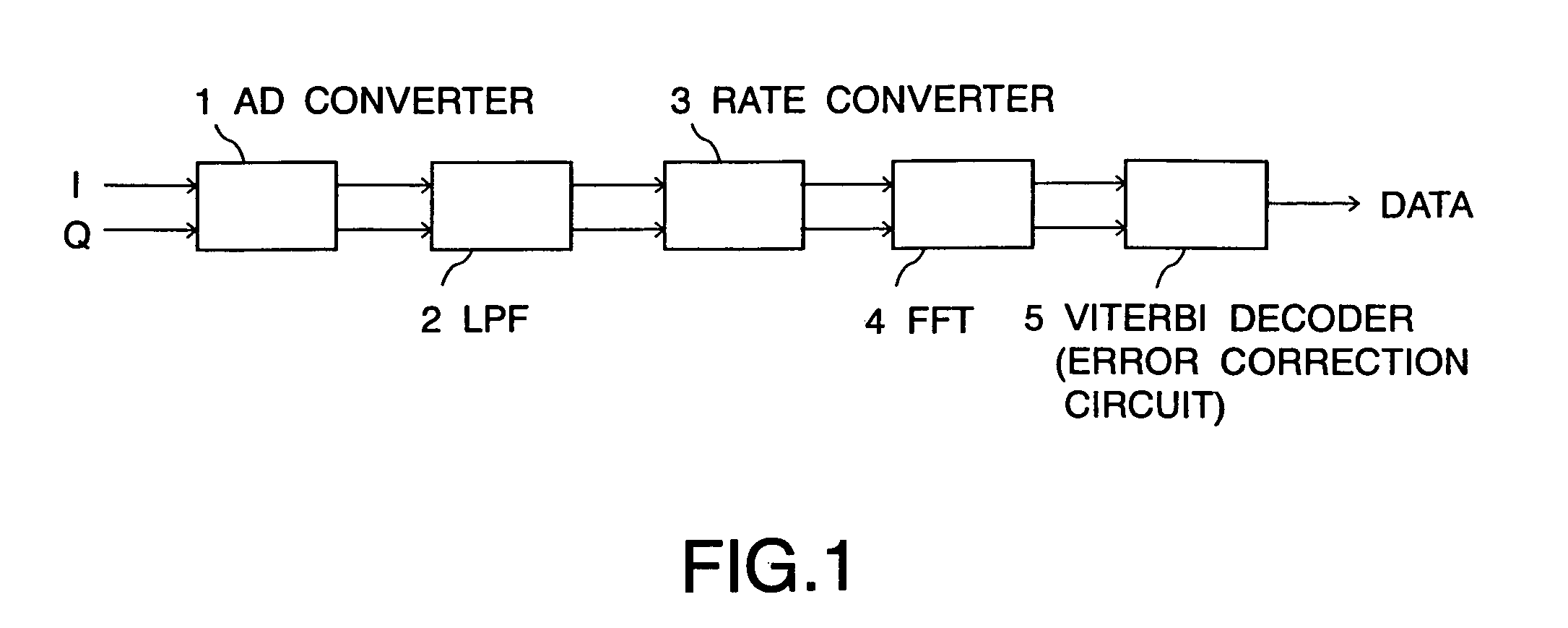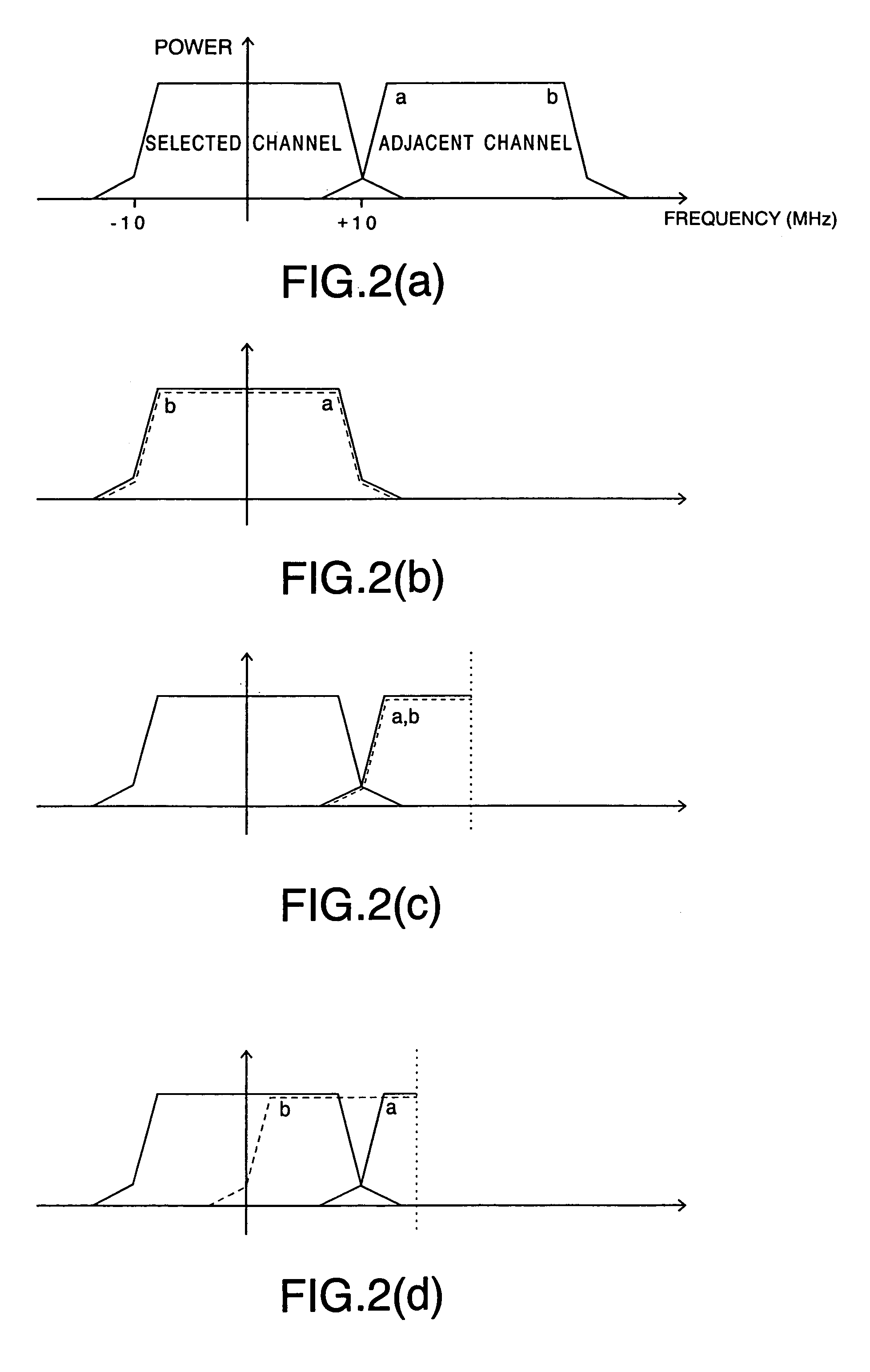System and method for receiving OFDM signal
a technology of ad converter and ad converter, which is applied in the field of system and method for receiving ofdm signal, can solve the problems of inability to reduce the power consumed in the ad converter or the circuit that executes digital signal processing, and the inability to adapt to mobile communication apparatuses
- Summary
- Abstract
- Description
- Claims
- Application Information
AI Technical Summary
Benefits of technology
Problems solved by technology
Method used
Image
Examples
first embodiment
(First Embodiment)
[0027]Wireless channels in the 5 GHz band, which are for use in the wireless LAN, are set at an interval of 20 MHz on the premise that signals subjected to (OFDM modulation are used therefor. An effective bandwidth per one channel is about 17 MHz, and there is a buffering band of about 3 MHz between one channel and a channel adjacent thereto. Therefore, when using a channel selection filter mounted with an RF or an IF, it is difficult to significantly remove a signal component of the adjacent channel. A base band signal converted from analog to digital and sampled. Then, a low pass filter (hereinafter referred to as “LPF”) by digital signal processing is realized, and the signal component of the adjacent channel is removed.
[0028]FIG. 1 is a block diagram of a system for receiving an OFDM signal according to a first embodiment. The system for receiving an OFDM signal of this embodiment includes an AD converter 1 which samples orthogonal signals of I and Q as digital...
second embodiment
(Second Embodiment)
[0045]In the wireless LAN using the OFDM modulation system in the 5 GHz band, there are standards such as IEEE 802.11a, HIPERLAN Type 2, and the like. Moreover, there are seven data transmission rates, including 6, 9, 12, 18, 27, 36 and 54 Mbps, and there are four subcarrier modulation systems, including BPSK, QPSK, 16 QAM and 64 QAM.
[0046]In the system for receiving an OFDM signal, the number of bits required for the operation differs depending on the modulation system for each subcarrier. For example, in order to deal with the 64 QAM modulation for use at the time of 54 Mbps as the maximum transmission rate, the AD converter samples 12-bit. Meanwhile, in the BSPK modulation for use at the time of minimum transmission rate of 6 Mbps, 8-bit sampling data is sufficient. Similarly, 10-bit sampling data is sufficient for 16 QAM modulation, and 8-bit sampling data is sufficient for QPSK modulation.
[0047]
Table 1 shows a relation between the number of bits and thetransm...
third embodiment
(Third Embodiment)
[0064]A block diagram of a system for receiving an OFDM signal according to a third embodiment is the same as FIG. 6 shown in the second embodiment. Modulation system detecting circuit 6 in the third embodiment detects a modulation system of a received signal, and in response to the detected modulation system, switches the sampling rate of the AD converter 1. For example, BPSK and QPSK are operated at the sampling rate of 30 MSPS, and 16 QAM and 64 QAM are operated at the sampling rate of 40 MSPS.
[0065]In this embodiment, since the sampling rate is switched in response to the transmission rate (modulation system), the modulation system at the slow transmission rate is operated at a low sampling rate, and thus the power consumption can be reduced. Moreover, the modulation system with a rapid transmission rate is operated at a high sampling rate, and thus the signal can be decoded stably without a large noise influence.
[0066]With regard to the AD converter 1 in this ...
PUM
 Login to View More
Login to View More Abstract
Description
Claims
Application Information
 Login to View More
Login to View More - R&D
- Intellectual Property
- Life Sciences
- Materials
- Tech Scout
- Unparalleled Data Quality
- Higher Quality Content
- 60% Fewer Hallucinations
Browse by: Latest US Patents, China's latest patents, Technical Efficacy Thesaurus, Application Domain, Technology Topic, Popular Technical Reports.
© 2025 PatSnap. All rights reserved.Legal|Privacy policy|Modern Slavery Act Transparency Statement|Sitemap|About US| Contact US: help@patsnap.com



